What is a Bee hive? 25 Amazing Facts
Honey bees are the most important species which help in the pollination of crops, plants, and trees. They migrate and live based on the floral sources in a region. mostly they live in forests and hills. They live in groups called bee colonies which can be otherwise called bee families.

Bee hive is the house for honey bees, in which - bees store their honey, lay eggs, develop their larvae, and live as a family. Its made of bee wax and generally are in pale yellow colour. Beehives are naturally built by honey bees in trees found in forests and hilly regions.
Man-made beehives are used by beekeepers. Its made of wood and consists of three parts namely, brood chamber, super chamber, and lid. Honeykart has its own bee farm with beehives.
Lets further look into the 25 Amazing facts about bee hive

Apiary
- Apiary is a place where beehive boxes are kept and should be free from pollution. This apiary of honeykart is shown in the image.
- Surrounded by enormous flowers to collect honey
- Natural water sources for bees
- Should be free from pesticides, else bees die
- Temperature should not be too hot
- Not in strong winds, so that bees can easily collect honey
Bee hive structure
- Bee hive or bee box needs to kept on stand to prevent it from ants
- Bee hive consists of three sections,
- Bottom brood chamber,
- Middle super chamber and
- Lid at the top
- Super chamber is most important for producing pure natural organic honey
- 99% beekeepers in India do not keep super chambers


Brood chamber in a beehive
- It consists of 7 frames of honey comb.
- This chamber contains the entrance at the bottom, through which bees can come and go out of the hive.
- Breeding of honey bees takes place in brood chamber
- Contains eggs, larvae, pupa and 30% honey & pollen to feed young bees
- Honey should not be harvested from this chamber
- The combs in this chamber are big, so more breeding of bees takes place, which increases population on bees and hence help in increase honey collection.
Brood frame of bee hive
- A wooden frame with projections for hanging inside the hive.
- Totally 7 such frames are kept in a brood chamber
- It consists of string at the center to give mechanical support to honey comb.
- It should be made of teak wood


Comb foundation wax sheet
- We make a comb foundation sheet from 100% pure bees wax.
- This is fitted in an empty frame and forms the foundation for bees to build a straight honey comb on it.
- Without a comb foundation sheet, the bees will not build a straight comb.
- A straight comb is necessary, else bees get killed while removing and placing combs in the bee box.
Forming a new bee hive
- A new bee hive needs to be developed from the brood chamber
- Three brood frames from a developed hive are separated and kept in an empty brood chamber.
- Now empty brood frame with the wax sheet is kept inside the hive, next to the fully developed frame.
- When enough bee flora is available, bees collect honey and convert it to wax to build the comb.
- Since bees are less in population, one brood frame will take 10 days to be constructed

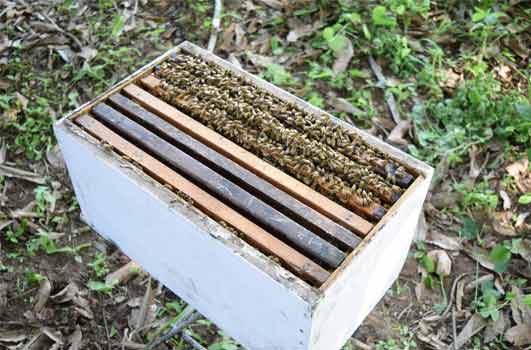
New brood chamber in bee hive
- Four new brood frames with wax sheet fitted are kept inside the hive.
- Bees will build brood frames one by one
- Queen bees will lay eggs in the finished cells of the comb.
- Now lid needs to be placed on the brood chamber.
- The empty super chamber should not be kept on a partially developed brood chamber
Developed Brood chamber
- After 1 month time, the entire brood chamber is filled with bees.
- Now each frame in brood chamber consists of 70% eggs and 30% of honey and pollen to feed eggs and larvae.
- As a good practice, honey should not be collect from brood chamber.
- But in India, beekeepers collect honey from brood chamber only and they don’t use super chamber at all.
- The brood chamber honey is meant for bees to feed larvae and eggs.
- Brood chamber honey will be used by bees during, non honey flow season.
- If brood frame honey is not extracted, artificial sugar feeding is not required during non honey flow season.
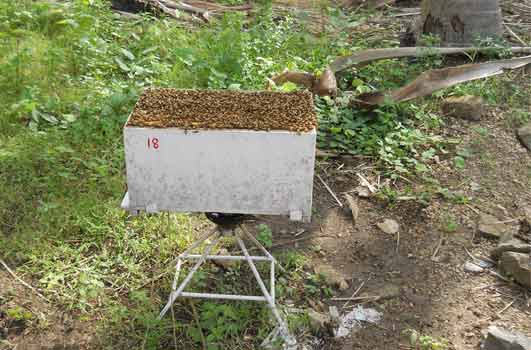
Adding super chamber to bee hive
- The Beekeeper is adding a super chamber to the bee hive. Only after the brood chamber is fully developed with bees, the super chamber needs to be placed on top of the brood chamber.
- The super chamber is also known as a honey chamber. It consists of only honey without eggs and larvae of bees.
- The super chamber consists of 7 frames but is small in size compared to brood frames.
- If enough bee flora is available, the super chamber will be filled with honey in 2 weeks.
- The super chamber will have top and bottom open, so bees can pass from brood chamber to super chamber for storing surplus honey.

Checking super chamber for honey storage
- Lid of bee hive is removed first.
- Since bees are now exposed to air, the bees slowly move from super chamber to brood chamber.
- If the combs in super chamber are bulged, then honey is full in super chamber.
- It’s now ready for harvesting.


Removing Super frames for honey harvesting
- The super honey frames needs to be removed one by one.
- If bees are aggressive, smoke produced by burning coconut fiber can be used.
- Honey bees in each super frame needs to be dusted into the brood chamber.
- The removed super honey frames is kept in empty super chamber beside me.
Honey bees from super chamber of bee hive
- The dusted bees present in the top of brood chamber frames moves down to the brood frames and continue some work there.
- The hive should not be kept open for long duration; else bees from other hives come to rob honey from this open hive.

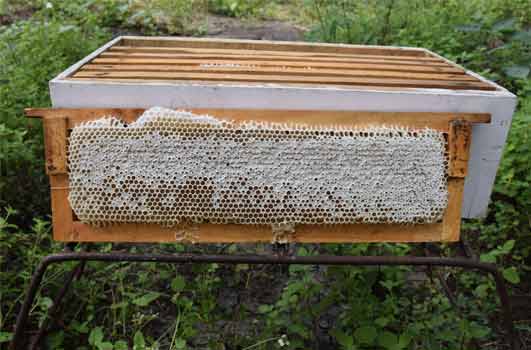
Super honey frame filled with honey and wax capped.
- Honeycomb is formed of numerous hexagonal tubular cells made of bees wax.
- In each tubular cell, the bees store honey.
- Once each cell is filled with honey, bees prepare wax and seal each cell to prevent honey from exposing to moisture in air.
- This is called wax capping.
- As honey is hygroscopic, it absorbs moisture from air and gets fermented.
- So bees do wax capping of honey to prevent fermentation.
Uncapping the wax to extract honey.
- Uncapping of wax needs to be done with sharp beekeeping knife
- It’s like removing the skin of a mango fruit.
- Wax capping needs to be removed on both side of the comb.
- This needs to be done slowly; else it would damage the cells of the comb

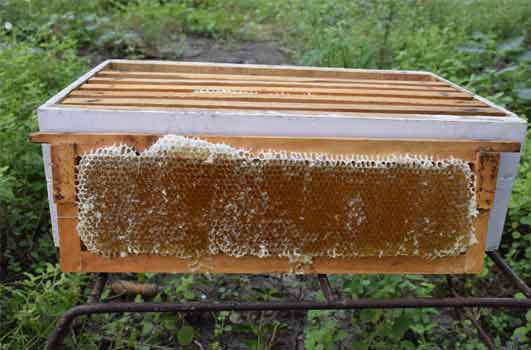
Uncapped super honey comb with honey
- The uncapped honey frame is ready for extraction.
- Uncapping is done to extract honey with best quality.
- Else comb needs to be squeezed, which will not produce best quality honey.
- Approximately 2kgs of honey will be available in this single frame
Stainless steel honey extractor
- This is one of the stainless steel extractor used in our farm.
- We don’t use iron or galvanized iron extractor, as that will degrade the quality of honey.
- In India 99% of beekeepers use ordinary galvanized iron honey extractors
- The iron rust in ordinary galvanized iron extractor will react with honey, which makes honey not suitable especially for babies and kid’s consumption.

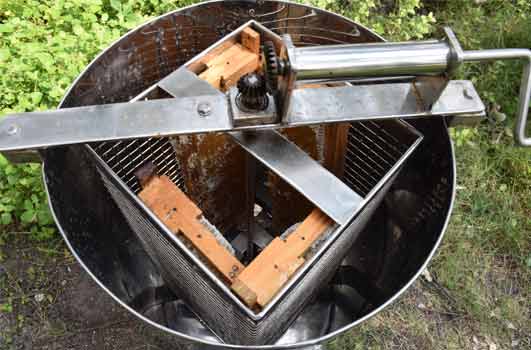
Fitting super honey frames in honey extractor
- Four super frames can be loaded at a time in this extractor.
- If the frames are not seated properly, then honey comb will be damaged during extraction.
- This is on-field extractor, which can be taken to different beekeeping sites for spot extraction
Extraction of fresh raw honey from the comb.
- Raw honey will have complete nutrition, it is extracted by the following process.
- If the extractor shakes during rotation, the combs will be damaged.
- So extractor needs to be held firmly, before rotation of the handle.
- On rotating the handle, only honey from the comb comes out due to centrifugal force.
- The frame and the comb will be held in position by the mesh present in the extractor.
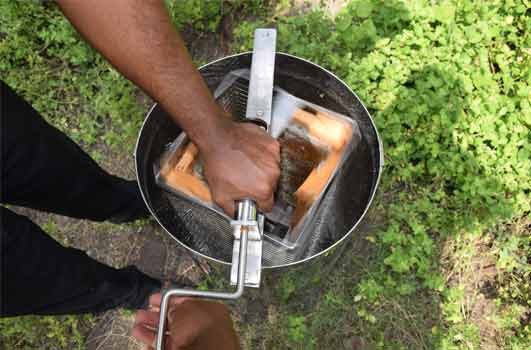

Honey settling at the bottom of the extractor
- The honey which hit the inner walls of the extractor during rotation, will now settle at the bottom of the extractor.
- The combs are empty without honey.
- The honey comb is intact with the frame without damage.
Empty super honey frame after honey extraction
- After honey extraction, the empty honey frames from the extractor are removed
- This needs to be placed back into the super chamber of the hive.
- We don’t cut and remove comb wax because 3kgs of honey is used by bees to prepare 1kg of bee wax.
- So, if this is kept inside the hive, the bees need not use honey to prepare wax again.
- It can immediately start storing honey in the comb.
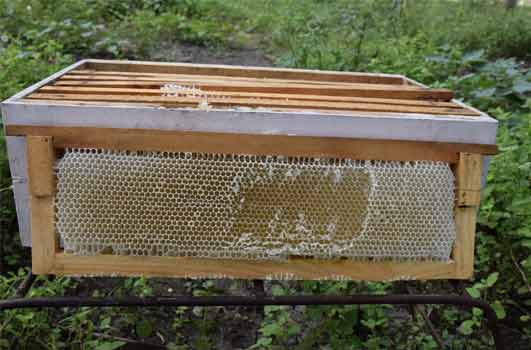

Loading back the empty honey frames into bee hive
- The empty super frames are brought back to the bee hives from which it was removed.
- One by one the empty frames needs to be kept inside the super chamber.
- This needs to be done gently without disturbing the bees.
- After keeping all the frames inside super chamber, the lid can be placed above the super chamber
On-field filtering of honey near bee hive
- As wax capping was removed from comb using knife, there may be small wax particles in the extracted honey.
- These wax particles needs to be removed.
- Immediate on-field filtration is best to maintain quality of honey
- Stainless steel filter is used for this purpose.
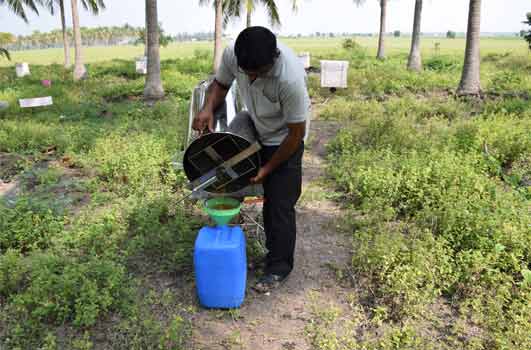

Honey filled in super chamber of bee hive
- Suppose honey is full and not extracted from super chamber, the bees will start to build natural comb in the space found between the lid and super chamber.
- This happens often in our apiary, during the honey flow season.
- Now the honey combs in the lid need to be cut and removed.
- The wax from these combs is used for preparation of wax sheets for our beekeeping purpose.
- Excess wax is supplied to cosmetic industry for organic facial preparations.
Honey comb in the lid of beehive
- These are the honey combs naturally built by bees inside the lid of the hive.
- When super chamber is full of honey and no space available to store honey in the hive, bees build combs naturally on inside the lid.
- The honey in this lid will be around 4 kg.
- Only honey will be stored in this comb, no eggs or larvae will be present.
- This comb honey taste will be awesome, if we chew honey along with the comb.


Honey beehives in Mango orchid
- These are the beehives on the mango farm.
- Based on the flowering season, we shift the beehives to floral sources.
- Pollination increases the crop yield by 30%
Frequently Asked Questions
- What are the parts of a beehive?
There are three parts in a beehive. They are
1. Brood chamber
2. Super chamber (also known as a honey chamber )
3. Lid
- What is the price of a beehive?
The price of a beehive ranges from Rs 1000 to 2500. This cost is primarily based on the type of wood used in making a beehive.
- What type of beehives are used in India?
Apis Mellifera beehive and Apis Cerana beehive are the two types of beehives used in India.
- What is a natural beehive?
Natural beehives are the hives built by the honey bees naturally living in forest and hilly regions.
- Where can I buy a beehive?
The best place to buy a beehive is from your local beekeeper found in your location.
- What is the colour of a beehive?
White colour is used for a beehive in high-temperature regions and green colour is used for the Hive in cold temperature regions.
- Do beehives need to be placed on a stand?
If your beekeeping location has many ants, then the beehive should be placed on a stand to prevent bees and honey from ants attacking.
- Whom should we contact for a bee hive removal?
If you are in a city location, then you need to contact the fire service department of your location for the removal of the beehive.
- Where can I buy honey online?
You can buy honey online at honeyKart. They door deliver honey to most of the cities in India.